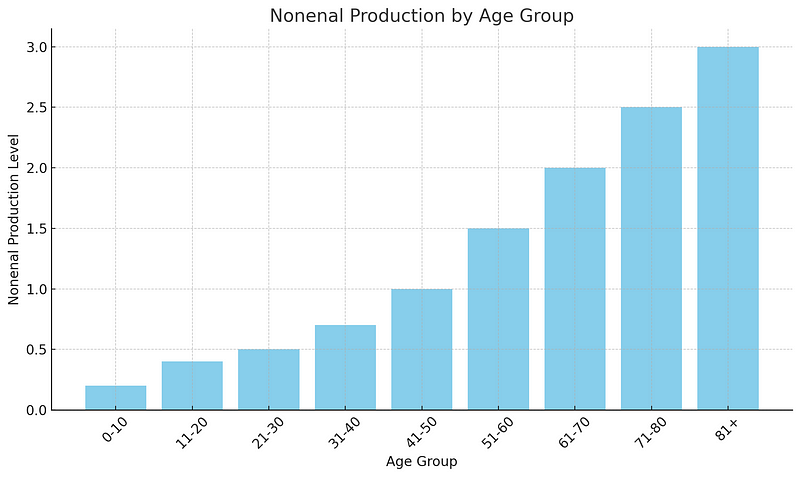# Embracing the Natural Aroma of Aging: A Scientific Perspective
Written on
Chapter 1: Understanding 'Old Man Aldehyde'
The concept of "Old Man Aldehyde" refers to a particular compound known as nonenal, which is often linked with the smell associated with aging. This article aims to explore the origins of this unique scent and explain why it emerges as a natural part of the aging process.

What is Nonenal?
Nonenal is an organic compound that increases in concentration as individuals age. It is classified as an unsaturated aldehyde, which involves:
- Unsaturated: This indicates that there are double bonds present among some carbon atoms within the molecule.
- Aldehyde: A category of chemical compounds characterized by a specific structural arrangement that dictates its reactivity.
The formation of nonenal occurs through the breakdown of omega-7 unsaturated fatty acids on the skin. This degradation process becomes more pronounced in older adults due to shifts in skin and body chemistry.
Why Does Nonenal Increase with Age?
As we grow older, our skin undergoes significant transformations. It tends to become thinner, less elastic, and the composition of its oils changes, leading to heightened nonenal production.
#### Hormonal Changes
Hormonal fluctuations profoundly impact our body's chemistry. As we age, these hormonal adjustments can alter the skin's oil production, resulting in elevated levels of nonenal.
Young versus Old
While younger individuals also produce nonenal, their bodies generate it in much smaller amounts due to higher antioxidant levels that help preserve fatty acids.

The accompanying graph illustrates how nonenal levels typically rise with age, starting from minimal amounts in childhood and increasing significantly among those over 81.
Perceptions of Nonenal
Reactions to the scent of nonenal can differ widely among individuals. Some may find it distinctive, while others might not notice it as much.
#### Cultural Perspectives
Cultural attitudes toward this scent can vary dramatically. In some cultures, it is perceived as a sign of wisdom and experience, whereas in others, it may carry less favorable connotations.
Managing Nonenal Production
Maintaining good hygiene and employing proper skincare routines can effectively manage nonenal levels. Gentle soaps and moisturizers can keep skin healthy and mitigate the scent.
#### Dietary Influences
A diet abundant in antioxidants may also help lower nonenal production by neutralizing free radicals that contribute to fatty acid breakdown.
#### Fabric Care Strategies
Since nonenal can adhere to clothing, regular washing and the use of fabric softeners can help reduce its presence on textiles.
Global Variations in Nonenal Production
Interestingly, nonenal production varies widely around the globe, influenced by genetic factors and dietary habits. For instance, certain diets rich in specific fatty acids can lead to higher levels of nonenal. This global diversity highlights the intricate connections between genetics, environment, and diet in shaping our bodily chemistry.
Nonenal in the Animal Kingdom
Humans are not alone in producing compounds like nonenal as they age; many animals also generate similar chemicals. However, their grooming habits and sensory adaptations often make these scents less detectable.
Historical Perspectives on Aging Scents
Historically, the scents associated with aging have held different meanings across cultures. In certain societies, these aromas signified respect and wisdom, showcasing the complex relationship between scent and social norms.
Changes in Skin pH with Age
With advancing age, the pH level of our skin shifts to a more neutral state, impacting the skin's microbiome. This change can influence not only nonenal production but also overall skin health, underscoring the importance of age-appropriate skincare.
Innovations in Cosmetic Research
The rise in nonenal production has prompted significant interest in the cosmetic industry. Researchers are exploring methods to mitigate this compound, leading to the development of specialized skincare products aimed at addressing aging concerns.
Health Implications of Nonenal
Although nonenal itself poses no health risks, its increased presence can indicate that older skin requires different care. As skin becomes drier and more delicate, it's essential to adopt gentler skincare practices.
Individual Detection of Nonenal
The ability to detect nonenal varies significantly from person to person. Some individuals are more sensitive to its scent, which can affect how they interact with older adults, highlighting the importance of understanding these sensory differences.
The Role of Antioxidants
Antioxidants are crucial for maintaining skin health, particularly in combating the oxidative processes that lead to nonenal production. By incorporating antioxidant-rich foods and skincare products into our routines, we can help counteract some effects of aging.
Conclusion
Understanding the chemistry behind 'Old Man Aldehyde' allows us to appreciate the natural aging process. Nonenal, which contributes to this unique scent, is a normal aspect of growing older. By gaining insight into it, we can approach aging with empathy, recognizing it as a shared journey.
Chapter 2: About Disruptive Concepts
Welcome to @Disruptive Concepts — your gateway to the future of technology. Subscribe for insightful videos every Saturday!